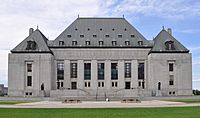Tsilhqotʼin Nation v British Columbia facts for kids
Quick facts for kids Tsilhqotʼin Nation v British Columbia |
|
|---|---|

|
|
| Hearing: 7 November 2013 Judgment: 26 June 2014 |
|
| Citations | 2014 SCC 44 |
| Docket No. | 34986 |
| Prior history | Appealed from British Columbia |
| Ruling | Appeal allowed |
| Court membership | |
| Chief Justice: Beverley McLachlin Puisne Justices: Louis LeBel, Rosalie Abella, Marshall Rothstein, Thomas Cromwell, Michael Moldaver, Andromache Karakatsanis, Richard Wagner |
|
| Reasons given | |
| Unanimous reasons by | McLachlin |
The case of Tsilhqotʼin Nation v British Columbia is a very important decision made by the Supreme Court of Canada. This ruling officially recognized Aboriginal land title for the Tsilhqotʼin First Nation. This decision had a big impact across Canada.
Because of this ruling, provinces can no longer simply cut down trees on lands that are protected by Aboriginal title. They must first talk with the First Nation that holds the title. This talk is called "meaningful consultation." Even if the First Nation doesn't agree with the activity, the government must still consult them before doing anything that affects their land rights.
Contents
What Happened Before the Case?
In 1983, the province of British Columbia gave a company called Carrier Lumber permission to cut trees. This was in a remote area of central British Columbia. This land was claimed by the Xeni Gwetʼin band, who are part of the Tsilhqotʼin Nation.
The Tsilhqotʼin people are a First Nations group. They have lived in this area for hundreds of years. They managed these lands and protected them from others. The Xeni Gwetʼin people blocked the area to stop Carrier Lumber from logging.
The company tried to talk with the provincial government to keep logging, but they were not successful. So, the Xeni Gwetʼin went to court. They wanted the court to stop Carrier Lumber's logging. They also wanted the court to confirm their Aboriginal title to the land. This land was part of their traditional territory.
Decisions in Lower Courts
The first trial for this case lasted five years. Both the federal and provincial governments disagreed with the Tsilhqotʼin's claim to the land. The judge in this trial looked at whether the Xeni Gwetʼin regularly and only used the land they claimed. The judge decided against their claim for technical reasons.
In 2012, the Tsilhqotʼin appealed this decision. The case went to the British Columbia Court of Appeal. This court also said that the Tsilhqotʼin did not own the land, except for a few small areas. This court used a stricter test. It looked at whether the people lived on specific parts of the land when Europeans first arrived.
Supreme Court's Important Decision
The Supreme Court of Canada, led by Chief Justice Beverly McLachlin, heard the appeal. All the judges agreed with the Tsilhqotʼin Nation. They ruled that the Tsilhqotʼin did have Aboriginal title to the land. This land was about 1,750 square kilometers (676 square miles) that they had used for a long time.
Understanding Aboriginal Land Title
The court explained that Aboriginal title means First Nations have a special right to use and benefit from the land. The government, called the Crown, still officially owns the land. But the First Nation gets to decide how the land is used. They can live on it, use it, and manage its natural resources, like trees or water.
However, the court also said there are times when the government can affect Aboriginal title. This can happen if it's for a very important public reason. But the government must follow these steps:
- First, the government must talk with the First Nation and try to find solutions.
- Second, the government's actions must be for a very important and clear public goal.
- Third, the government must act fairly and responsibly towards the First Nation. This is called a "fiduciary obligation."
See also

